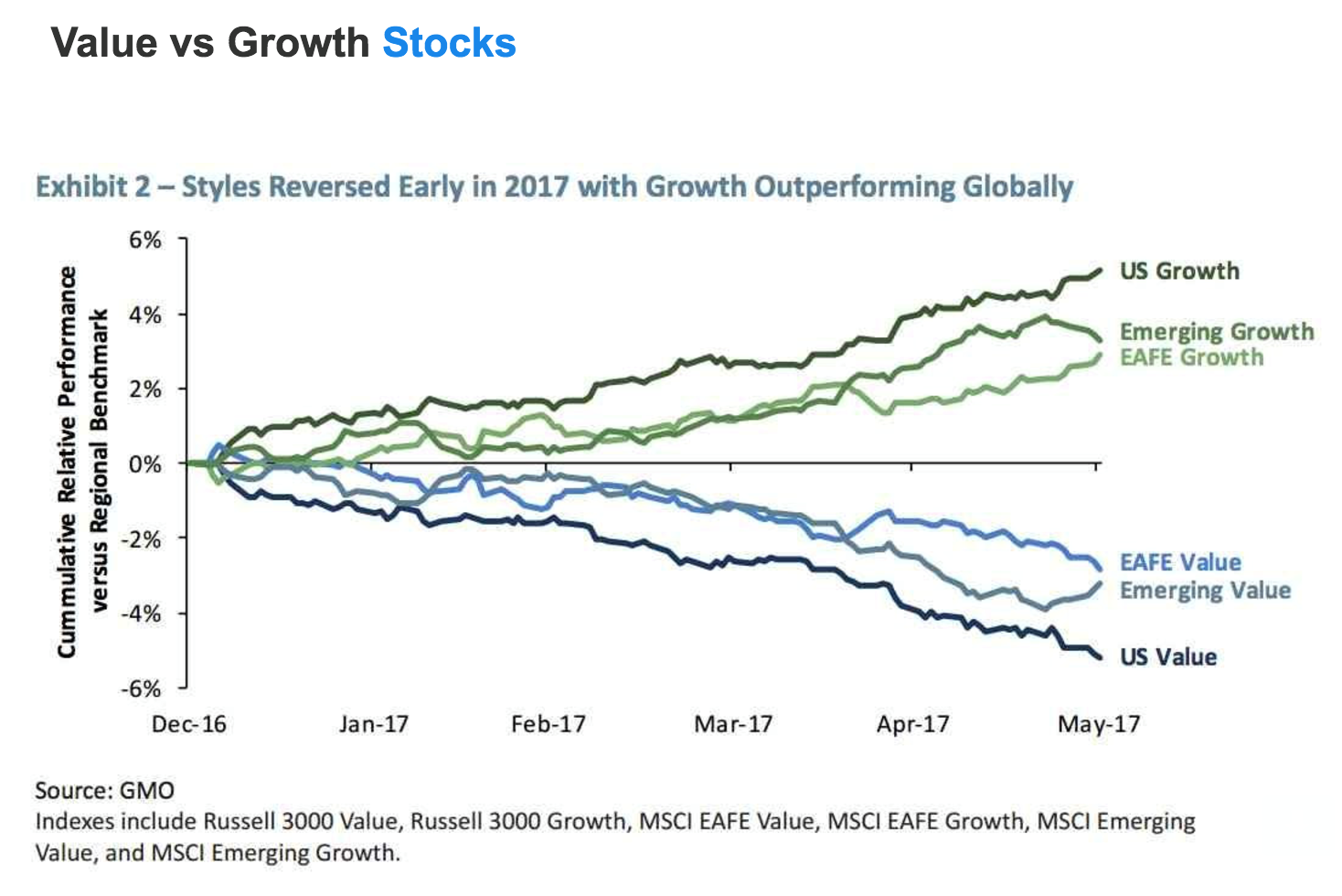Finding The Best Investment
Investment Perspective – August 2017

Peter Flannery CFP AFA
“Neither the investing method nor the fundamentals of the business are right or wrong because the mood of the market is favourable or unfavourable toward the “stock”. That is because when you really think about it, “stocks” (shares) are all about the financials and the trading price, the share price… the cash up value. What matters more is the economics of the business”
Peter Flannery

What is the above chart telling you? How useful is that information?
The chart above is telling us that growth type stocks are better than value type stocks…since December last year. In case it’s not obvious, first look at this chart says growth is better. Look more closely and you see the sample period is a few months – meaningless as we are looking to invest in the future outside the sample period covered by the chart and of coarse six months is a brief moment in history, hardly a reliable sample of time.
Also we, as experienced value investors know that the lines on the graph represent the collective price movement (of each “stock” type). We know that price movement measures market sentiment, not necessarily the fundamentals of those businesses collectively and certainly not the individual economics of individual businesses with in the sample.
You and I invest in specific businesses rather than playing the market. I could go on further but suffice it to say that the above chart sends a clear message to those looking for a quick “fix’’ or who are wanting something to support a certain opinion. It is of limited use for you and I as serious investors.
OK – One more thing…there is a lot to be said for understanding our investing methodology and adhering to it, no matter what.
Neither the investing method nor the fundamentals of a business are wrong because the mood of the market is favourable or unfavourable toward a “stock”. That is because when you really think about it, “stocks” (shares) are all about the financials and the trading price, the share price…the cash up value.
The cash up value is no more likely to reflect the underlying intrinsic value when markets like a stock and over price it than when the market dislikes that same business and under prices it. The intrinsic value is a function of the underlying business performance – not the market mood or the trading price.
Where does WISEplanning fit into it all?
There is a massive amount of material around investing. When you start getting into it, some / a lot is contradictory if not confusing.
WISEplanning, over time, has developed its own methodology, admittedly based around Warren Buffett and Charlie Munger’s value investing methodology, which was founded by Benjamin Graham.
As advisors we are about investment suitability for our clients. This means designing investment portfolios and investing strategies that match our client’s specific circumstances and investment goals.
The “Value” method has been developed and further advanced at WISEplanning and now extends to other assets (in addition to big businesses listed on the share market, we can now apply it to residential property and small business (owner operated)).
For advanced investors who already have the money, who want to protect and grow their capital as well as possibly generate income, we prefer investing in the business with sound economics (as opposed to playing the markets).
For many years, Berkshire Hathaway invested and achieved results that others could neither match nor understand. Indeed, even today, this approach to investing is rare and still not well understood. Evidence of that (the lack of understanding) is the proliferation of not only passive low cost index funds but also a variety of other managed funds, with a multitude of different styles, approaches and methodologies.
The one clear trend across most investment approaches, which includes share brokers / momentum investing, passive index funds and active managed funds is the use of modern portfolio theory.
The problem with modern portfolio theory
In simple terms, the idea is to diversify to help manage risk.
Risk is seen as the variability in the cash up value of investments. In other words, when the trading price of an investment or the whole portfolio declines, this is seen by modern portfolio theory practitioners as a risk to be minimized or avoided.
Funny that, because for us as value investors, when prices decline, the risk also declines because productive assets can be acquired at a lower price (i.e buying assets at expensive prices = risk), but not so for modern portfolio theory practitioners. To them, declining prices is a risk they need to avoid and manage!
“When prices decline, the value emerges.”
“I don’t know if Harley Davidson stock is worth $20 or $30. I like a business where customers tattoo their name on their chest – I’m not sure you can go around questioning those guys!“
Warren Buffett – BRK Annual Meeting 2010
